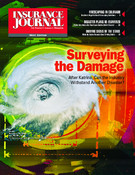Dr. Robert Moore, former senior vice president of Alexander & Alexander Services Inc. (now owned by Aon Corporation), and also past president of the National Association of Insurance Brokers, sat down recently with his collaborator, John Bogardus Jr., in a question-and-answer interview on his perspective on nearly three centuries of U.S. commercial insurance.
Bogardus, with Moore, authored the newly-revised 2005 paperback edition of Spreading the Risks: Insuring the American Experience. He joined Alexander & Alexander in 1950 and rose through the ranks to become president, CEO and chairman, serving on the board from 1963 to 1995. Active in several national insurance organizations, he also served on the boards of Donaldson, Lufkin & Jenrette Inc.; Security Capital Corporation; and United States Surgical Corporation.
Robert Moore: What aspect of Spreading the Risks do you believe is its most important contribution?
Jack Bogardus: Readers’ comments are most positive about our overview of the industry’s early history in America, the 19th-20th century growth of brokers, and our Lloyd’s discussion. However, from my perspective, I believe the greatest contribution is in locating unique historical records that were not being preserved. Fortunately, I was able to obtain company histories that were privately held or otherwise not in the public domain. For major brokers such as Alexander & Alexander, Frank B. Hall and others, without our efforts, the story of their roles in the country’s economic development would have been lost forever.
Moore: You’ve been associated with commercial insurance for over 50 years, what most surprised you in your research?
Bogardus: I was surprised to learn how few early insurers survived for any length of time. This reflects many factors including lack of capital, insufficient or lack of reserves and very little spread of risks (especially for the fire peril). Even wealthy individuals who backed companies by posting collateral notes found they couldn’t pay large, unanticipated claims. Most surprisingly, although they operated in an information vacuum about their actual exposures, early insurers often engaged in competitive price wars!
Such mistakes led to the demise of the majority of companies. The Hartford Fire Co., which began in 1810, almost cratered within 10 or 15 years and only miraculously survived. The St. Paul, established in the early 1850s, sold its office furniture to stay in business. The Little Aetna’s directors contributed their own money to keep the company afloat. The INA was one of the very few who had reasonable financing and was relatively free of major problems.
Moore: What were some of the risks addressed by early insurers?
Bogardus: The need for fire insurance seems particularly obvious; however, clients were slow to accept it. Even at the start of the 20th century, agents and brokers had difficulty persuading people to insure their homes against fire. A&A, for example, resorted to dramatic ads showing with firemen using ladders to rescue children from burning buildings.
Moore: In the modern era, what risks were problematic?
Bogardus: Unfortunately, underwriters have offered policies that provide such broad coverage that unintended perils are covered for which no premium was calculated. For example, asbestos and the diseases it causes have cost underwriters billions of dollars. Warnings about potential health hazards associated with asbestos were issued periodically after World War I in the United States and the United Kingdom. Liability underwriters should have taken such concerns more seriously, but they were not reflected in their underwriting decisions. For years, no asbestosis claims materialized, but by the mid-seventies, they proliferated. By then, it was too late.
Another example, in the mid-1970s, Lloyds’ underwriters offered insurance for rental income loss when computer leases were canceled as computers became obsolete. Minimal due diligence should have determined that inevitable technological advances would lead to lease cancellations. By failing to anticipate, underwriters suffered huge claims.
On the positive side, the industry has frequently responded innovatively to diverse risks. In the 1880s, they began writing tornado insurance, followed by burglary, and then fidelity and surety bonds. Throughout the 20th century, insurers have successfully faced an extremely complex array of new risks; and after 9/11, there was great success in developing new capital, particularly in establishing Bermuda insurers.
Moore: Spreading the Risks reports on what one reviewer calls “anecdotes of heroes and villains;” another says your discussion of various UK frauds reads at times “like a John Grisham novel.” Are there aspects of these earlier events that are pertinent to today’s widely publicized problems at AIG, Marsh, and others?
Bogardus: Probably the most significant pattern is that of age-old human frailties such as of hubris, arrogance and greed. Especially remarkable is the pattern of highly intelligent and successful managers who are associated with decisions that tarnish or destroy otherwise brilliant careers. In the case of A&A’s problems with Howden, we were confronted with individuals who siphoned off money for their private use by using complex schemes involving off-shore companies.
Moore: How did the early agency/brokerage system get started?
Bogardus: The advent of agents and brokers really drove the growth and development of insurance. Huge sales forces pushed various coverages and were also instrumental in developing new products. Some companies thought it was a waste of money and refused to build a sales force, but they quickly fell by the wayside. Next came the development of general agents with a big territory, sometimes a state. They hired others to work for them. Special agents for one company also became commonplace. As risks became larger, one company could not cover them. Brokers responded by getting coverage for large and increasingly complex risks from multiple insurers.
It’s surprising how few people know the history of commercial insurance in America. That’s unfortunate because it is indisputable that the industrial revolution and the country’s remarkable economic expansion since the 1940s could not have occurred without a vibrant commercial insurance industry. Spreading the Risks authoritatively documents these facts. As an industry, we need this self awareness, especially at a time when we have been under attack.
Moore: What propelled you to devote 13 years researching and writing the book?
Bogardus: I began with a great curiosity about the men who started Alexander & Alexander and came to realize that most readers would not be interested in such a narrow focus. It occurred to me, why not tell the story of America’s agents and brokers? There was no single book that adequately covered them and I thought, who is going to do this? Then, when I gained access to unpublished material, I realized that if I didn’t do it, it might never get done.
Moore: What was the most challenging part of the process?
Bogardus: Finding relevant sources was difficult, and required a lot of leg work. I had the indispensable assistance of people such as Jean Lucey at the Insurance Library Association in Boston and the staff of other libraries. Even when sources were available, they were frequently ancient copies that required careful handling. I also had to go thought a lot of old newspapers. In one instance, I turned up a new member of the Alexander family by finding his gravestone. His heirs had not been aware of his existence.
Moore: Did you have periods when you were close to abandoning the project?
Bogardus: I always knew it would get done but never in my wildest imagination expected it to take 13 years. Frankly, I may not have undertaken the project if I had known the commitment required. This doesn’t even include the challenges of taking the book through the publishing and distribution process.
Spreading the Risks: Insuring the American Experience by John A. Bogardus Jr. with Robert H. Moore, has been widely praised throughout the insurance industry. Information about the 2005 revised paperback edition of Spreading the Risks is available at www.spreadingtherisks.com.
Was this article valuable?
Here are more articles you may enjoy.


 Berkshire Shareholders Reject Diversity, AI Proposals
Berkshire Shareholders Reject Diversity, AI Proposals  Auto Insurance Market Stays Rational Despite Improved Trends, Says Allstate
Auto Insurance Market Stays Rational Despite Improved Trends, Says Allstate  Buffett to Step Down Following Six-Decade Run Atop Berkshire
Buffett to Step Down Following Six-Decade Run Atop Berkshire  Q1 Has Lowest Insurance Agency M&A in 5 Years; Mega Deals Coming?
Q1 Has Lowest Insurance Agency M&A in 5 Years; Mega Deals Coming? 


